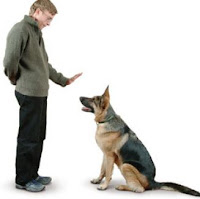Every interaction with your puppy is a training opportunity.
The first few days of bringing your new puppy home are extremely important. Don't let the excitement of your new puppy sway you from the rules you have set in place. It's very confusing to a dog to allow them on the furniture or to jump up on you at first and then later decide that you don't like it. You must set your boundaries from the start and stick to them.
 It will be very tempting to let your puppy out of his crate and up on the bed with you so that he doesn't cry all night, but by doing this you are starting a whole new set of problems. By letting your puppy out when he whines and cries you are teaching him that when he fusses you are going to give him what he wants meaning whenever he wants out of his crate, back inside, up on the couch, up on your bed, your food at the table, or anything else, he is going to whine and cry and bark because he has learned that doing so gets him what he wants.
It will be very tempting to let your puppy out of his crate and up on the bed with you so that he doesn't cry all night, but by doing this you are starting a whole new set of problems. By letting your puppy out when he whines and cries you are teaching him that when he fusses you are going to give him what he wants meaning whenever he wants out of his crate, back inside, up on the couch, up on your bed, your food at the table, or anything else, he is going to whine and cry and bark because he has learned that doing so gets him what he wants.If that doesn't convince you to want to keep your pup in his crate, also remember that by allowing him freedom at night you are setting him up for failure because your puppy does not know how to hold his bladder all night and you are likely to wake up to a big mess the next morning. Not to mention all the items your puppy will likely find to chew on in order to soothe his aching teeth and gums.
 It's hard to ignore the crying of your new bundle of fur. Your new puppy has just been taken away from his mom and litter-mates. He is vulnerable and impressionable. What he needs now is security and routine. It sounds like a good idea to take a few days to spend with your new puppy, but this is actually the worst thing you can do. Your puppy needs to get used to the routine of the household from the start. If you are gone during the day or night, your puppy needs to get used to this right away. Otherwise he's going to be even more confused and upset when he's been used to seeing you all the time and suddenly you are gone. This creates separation anxiety in dogs and can become an extreme health problem if not addressed. To help your puppy sleep better through the night, think about getting a Snuggle Puppy which is a soft puppy toy with a warmer and a heartbeat that helps your puppy to not feel alone and mimics being back with his mom and litter-mates.
It's hard to ignore the crying of your new bundle of fur. Your new puppy has just been taken away from his mom and litter-mates. He is vulnerable and impressionable. What he needs now is security and routine. It sounds like a good idea to take a few days to spend with your new puppy, but this is actually the worst thing you can do. Your puppy needs to get used to the routine of the household from the start. If you are gone during the day or night, your puppy needs to get used to this right away. Otherwise he's going to be even more confused and upset when he's been used to seeing you all the time and suddenly you are gone. This creates separation anxiety in dogs and can become an extreme health problem if not addressed. To help your puppy sleep better through the night, think about getting a Snuggle Puppy which is a soft puppy toy with a warmer and a heartbeat that helps your puppy to not feel alone and mimics being back with his mom and litter-mates. Remember, your puppy is very impressionable. Puppies learn very quickly when given the proper instruction. Never hit your puppy or give harsh reprimands. Your puppy does not mean to misbehave, as he is simply being a puppy. And if he does something wrong it is because he has not been taught the rules. Teach your puppy to play with his toys. Make them fun and exciting. If you catch your puppy chewing on furniture, tell him "Off!" and immediately give your puppy a proper chew toy and praise him for chewing on it.
Remember, your puppy is very impressionable. Puppies learn very quickly when given the proper instruction. Never hit your puppy or give harsh reprimands. Your puppy does not mean to misbehave, as he is simply being a puppy. And if he does something wrong it is because he has not been taught the rules. Teach your puppy to play with his toys. Make them fun and exciting. If you catch your puppy chewing on furniture, tell him "Off!" and immediately give your puppy a proper chew toy and praise him for chewing on it.Grannick's Bitter Apple Spray works great as a chew deterrent. This no chew spray has a taste most dogs find unattractive and will help stop your pup from chewing on the item that has been sprayed.
If you don't catch him in the act, don't do anything, your puppy will just be confused. Many people believe their dogs know when they have done something wrong because they look guilty, this is not true. Dogs do not feel guilt, that is a human emotion. The dog looks that way because he knows you are angry and he is trying to send calming signals by crouching down and giving you sideways looks so that you will not hurt him.
When training your puppy, remember these key things:
- Be patient.
- Be consistent.
- Be confident.
- Use treats/toys.
- Try the replacement theory.
- Hold the leash properly.
- Utilize confinement (the crate).
- Learn from others (socialization).
- Stop the biting (teach bite inhibition).
- Use discipline, not cruelty.
For all of your puppy supply needs such as toys, chews and treats, visit Mickey's Pet Supplies.
Take 15% off your first order with code FORPUPPY. with any order from our For Puppies category, excluding Orijen Puppy Food.
Take 15% off your first order with code FORPUPPY. with any order from our For Puppies category, excluding Orijen Puppy Food.
For more tips on training, go to www.calm-training.com or email Heather at calmtraining@outlook.com





